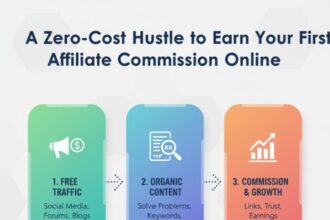Instantly Resolve Your Google AdSense Policy Violation with These Tips!
The cursor blinked. Once. Twice. Mocking me from inside the compose window of a new search.
My hands felt weirdly disconnected from my body, hovering over the keyboard. I think I was holding my breath.
I’d just read the email for the tenth time. The words hadn’t changed. They were still there, stark and cold in my inbox: “Important: Google AdSense Policy Violation.”
It’s just an email, right? Not a big deal in the grand scheme of things. But in that moment, it felt like a judgment from on high. My little blog, my late-night project I’d poured my heart and countless cups of stale coffee into, suddenly felt like it was about to be wiped off the map. My stomach did a sick little lurch.
My first, frantic thought wasn’t rational. It was a jumbled, panicked prayer. I just needed to figure out how to instantly resolve your Google AdSense policy violation with these tips! I actually typed that whole desperate phrase into Google, as if a magic answer would just pop up and make it all go away.
It didn’t, of course.
What popped up was a nightmare of confusing advice, technical jargon, and scare stories from other bloggers. It was the beginning of a week-long descent into a rabbit hole I never knew existed.
This isn’t a guide from an expert. I am so, so far from being an expert. This is just… my story. The raw, unfiltered account of how I navigated that soul-crushing panic and what I learned along the way. It’s messy. But it’s real. And if you’re staring at that same email right now, I hope my mess can help you find your way through yours.
My First Clumsy Steps Into the Belly of the Beast
My initial reaction was to “fix” it. Immediately. I had this frantic energy, this need to do something, even though I had no idea what to do.
It was like trying to patch a leaky boat with chewing gum in the middle of a storm.
I clicked the link in the AdSense email, and my screen was instantly filled with what looked like a legal document from another dimension. The language was dense. Corporate. Utterly impenetrable. I read paragraphs three times and still couldn’t figure out what they were trying to say.
It felt like being sent to the principal’s office, but the principal was a robot who only spoke in code.
A Whole New Language Designed to Make Me Sweat
The policy violation notice was a masterpiece of corporate vagueness. It mentioned something about my site having “no value” or “thin content,” but it didn’t point to a single page. Not one. It was an accusation without evidence.
So, I did what any terrified person does. I started Googling every single word.
This led me straight into the weeds. I became obsessed with my invalid traffic concerns. I’d read horror stories on forums about “click bombs” and rival bloggers sending malicious bot traffic to get your site banned. For two solid days, I stared at my Google Analytics, questioning every single visitor. Was that spike from Finland a bot? Did my aunt from Florida click an ad by mistake? I was losing my mind.
Then, my paranoia shifted to my own writing. I stumbled upon the list of prohibited content categories, and my heart sank. Okay, I don’t have a website about illegal fireworks or anything, but the rules felt so… subjective. What if a story I told was too edgy? What if a joke I made three years ago crossed some invisible line? I started to feel like a criminal, and I couldn’t even figure out what crime I’d committed.
It feels like Google sees your website as a little shop in their giant, pristine shopping mall. They want every shop to be clean, bright, and welcoming. They don’t want anything weird or unpredictable that might scare away the high-paying customers (the advertisers). And my little shop, apparently, had a weird smell and some flickering lights. I just couldn’t figure out where they were coming from.
My Brilliant Idea That Was, Unsurprisingly, Not Brilliant
After days of this self-inflicted torture, I decided I had to act. I couldn’t just sit there.
So, I made a list of posts that felt… suspicious. I don’t even know what that means, but I deleted them. Five of them. Gone. Then I found a plugin that claimed to have an “AI-powered firewall,” which sounded impressive, so I installed that.
Feeling cautiously optimistic, I went back to AdSense and clicked the “Request Review” button.
I even wrote a little note. I tried to sound professional. “To whom it may concern,” I wrote, “I have reviewed my website and addressed the policy issues. Thank you for your consideration.”
It was a total disaster.
A few days crawled by. Then, the same email. Same subject line. Same cold, robotic tone. The problem was still there. My “fix” had done absolutely nothing.
That was the moment the panic turned into something else. A hollowed-out feeling of defeat. I was just guessing. I was a toddler trying to fix a Swiss watch by banging it on the floor. I realized I didn’t just need to try harder; I needed to change my entire way of thinking. I was playing the game all wrong.
That Mountain of Bad Advice I Had to Climb Over
Once the sting of that second rejection faded, I did something different. I stopped trying to fix things, and I started trying to understand.
I brewed a fresh pot of coffee, opened a new notebook, and went back to the source: Google’s own documentation. I promised myself I would read it slowly, even if it made my brain hurt.
And as I did, I realized something important. A lot of the “common knowledge” I’d picked up from forums and old blog posts was just… myth. Legends passed down from one panicked blogger to another.
The Big Lie: “One Strike and You’re Out for Good.”
This was the fear that had been fueling my panic. The idea that this one violation email put a permanent black mark on my name. That I was now on some secret, unfixable “naughty list.”
But it just doesn’t seem to be true.
The more I read, the more I saw the violation as a warning light on a car’s dashboard. It’s not telling you the engine has exploded. It’s just saying, “Hey, you might want to check the oil.” Google wants you to succeed. Seriously. They make money when your site makes money. It’s a partnership. A very, very imbalanced partnership where one partner is a trillion-dollar company and the other is me in my sweatpants, but a partnership nonetheless.
The real trouble, it seems, comes from ignoring the light. Or from just putting a piece of tape over it and pretending it’s not there. They aren’t looking for perfection. I think they’re just looking for a good-faith effort. They want to see that you care enough to understand their rules and try to follow them.
The Sneaky Problem That’s Not Actually Hackers
I wasted so much emotional energy worrying about sabotage. But the truth for most of us small creators is usually a lot more mundane. And it’s often our own fault.
Take comments, for instance. I love the comments on my blog. They make me feel like I’m not just shouting into the void. But I never really thought about what I was allowing to be posted there. This is where I learned about user-generated content moderation. It’s a dry phrase, but what it means is critical: if a reader posts a spammy link or something awful in your comments, it’s your site. You are responsible. That was a huge wake-up call. Google even has a whole page about it, which you can find on their official AdSense help site.
The same goes for ad placement. It’s not about evil bots. It’s often about clumsy design. Is your ad so close to a menu button that people on a phone are bound to fat-finger it? That’s not a malicious attack; it’s just a bad layout. And it’s something completely within your power to change.
“But My Website Theme Looks So Pretty!”
Oh, this one hit me hard. I loved my website’s theme. I’d picked it out years ago because it had a cool font and a nice color scheme. I never once thought about what was going on under the hood.
Then I fell down the rabbit hole of AdSense-friendly themes.
I learned that a theme isn’t just a skin. It’s the entire skeleton of your website. A good theme is built for speed. It’s designed to be responsive, meaning it automatically adjusts to look good and work properly on a tiny phone screen. And, crucially, it has ad slots that are placed thoughtfully, in ways that don’t trick or annoy the user.
Switching my theme felt like moving houses. It was a massive pain. But it was also the first time I felt like I was actually fixing the root problem, not just patching up the cracks. I was rebuilding on a solid foundation.
The One Simple Idea That Changed Absolutely Everything
The real shift for me wasn’t a technical trick or a secret setting. It was a change in my perspective. It was a single, simple idea that made all those confusing rules suddenly snap into focus.
I had been spending all my energy asking one question: “What do I have to do to make Google happy?”
And that was completely the wrong question.
The question I needed to ask was: “What can I do to make my reader’s life easier?”
That’s it. That’s the whole secret.
Google’s entire business model is built on giving people the best possible answers and the best possible experience. Advertisers pay billions for access to that experience. They don’t want their ads showing up on junky, frustrating, or useless websites because it makes them look bad by association.
So, every single one of AdSense’s rules, from content quality to ad placement, is really just a way to measure one thing: the quality of your website’s improving user experience.
How I’d Been Seeing My Own Website Wrong
Before this whole mess, I viewed my site in two parts. There was my writing, my stories, the stuff I poured my heart into. Then there were the ads, which were just this thing I tacked on to hopefully pay for my web hosting.
I saw them as completely separate. A necessary evil.
This was a fundamental misunderstanding of how a visitor sees it. To them, it’s all one thing. It’s the website. If an ad is obnoxious and covers the text, the website is obnoxious. If the page loads slowly because of heavy ad scripts, the website is slow.
My job wasn’t to get people to click on ads. My job was to create a place that was so helpful, so enjoyable, and so easy to use that the presence of a few ads was a perfectly acceptable price of admission. It flipped my entire creative process on its head. I talk a bit about this journey in my post on Why I Stopped Chasing Traffic and Started Chasing Value.
Putting on a Stranger’s Glasses
Armed with this new philosophy, I did something incredibly humbling. I tried to look at my own blog as if I were a complete stranger who had just landed there from a random search.
And oh, it was bad.
The menu was confusing. Some of my best posts were buried three clicks deep. On my phone, the text was weirdly small, and an ad banner completely covered my site’s logo. It was a clunky, frustrating experience. I wouldn’t have stayed for more than ten seconds.
From that point forward, every decision became simple. Does this change help the reader? Yes? Do it. No? Don’t. It was a filter that cut through all the noise and told me exactly what I needed to do.
My Battle-Tested, Definitely-Not-Official Recovery Plan
So, what did I actually do? What did that week of panic and frantic work look like? This isn’t a checklist from on high. This is just my personal playbook, forged in the fires of frustration. This was my own little AdSense appeal process, and it worked.
Step 1: The Brutally Honest Self-Audit.
The very first thing I did was become my own worst critic. I opened my website in a private browser window, so there were no cookies or logged-in magic. I imagined I was a grumpy, impatient person with only 30 seconds to spare. I clicked everywhere. I tried to find my own contact page. I looked for my most popular article. I was ruthless. This exercise is backed by tons of research; usability experts at places like Nielsen Norman Group have shown that users are incredibly impatient online. I had to design for that reality.Step 2: I Became a Librarian for My Own Site.
My site’s navigation was a mess. It was an afterthought. I realized that solid website navigation best practices aren’t just for show; they’re fundamental to the user experience. If a person can’t find what they’re looking for, they’ll leave. It’s that simple. So I sat down and completely re-thought my menu. I simplified my categories. I made sure my search bar was prominent. I wanted to make it impossible for someone to get lost. It’s a topic I feel so strongly about now, I even wrote about my Journey to a Clutter-Free Navigation Bar.Step 3: The Great Content Purge of ’24.
This part was painful but necessary. I went through every single post on my blog. Every. Single. One. I asked myself, “Is this post genuinely helpful or interesting today?” If the answer was no, it was gone. I deleted over 30 old posts that were short, outdated, or just plain weak. It felt like trimming a dead plant. It hurt a little, but it was essential for new growth. I also paid close attention to ad placement within the posts, making sure there was plenty of space and they never felt deceptive. Esteemed sources like Search Engine Journal offer great insight into what makes content valuable in today’s landscape, and I used that as my guide.Step 4: I Became a Bouncer for My Comments Section.
No more “auto-approve.” Period. Now, every single comment waits for my approval. It takes maybe five minutes out of my day. I get to read the lovely notes from real people and nuke the spammy garbage with a click. It gives me complete control and peace of mind. It’s my site. I get to decide who gets to speak here.Step 5: I Wrote My Appeal Like a Human Being.
When I was finally ready to ask for a review, I didn’t use a corporate template. I wrote from the heart. I opened with, “Hello, I believe I now understand what I was doing wrong.” I explained my old, flawed thinking. I then detailed the exact steps I took—changing my theme, auditing my content, fixing my navigation—and, crucially, I explained why I did each thing, linking it all back to improving the experience for my visitors. I was showing them I hadn’t just ticked boxes. I’d actually learned something. And that, I think, made all the difference.
So, Where Am I Now?
Have I cracked the code? Am I an AdSense wizard?
Heck no. Not even a little bit. But I am a better blogger. I am a more thoughtful creator. That email, the one that sent me into a full-blown panic, was actually a gift in disguise. A very, very stressful disguise.
It forced me to stop just making content and start building a home for that content. A place that was welcoming, helpful, and respectful of a visitor’s time and attention.
The craziest part is that once I stopped worrying so much about the algorithm and started worrying about the person reading my words, the algorithm took care of itself.
So if you’re in that dark, panicky place right now, just breathe. This isn’t the end. It might just be the push you need to make your little corner of the internet better than you ever imagined.
What’s the one small thing you’ve been putting off that you know would make your site just a little bit better for someone else? Maybe start there.










































